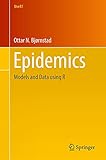Epidemics [electronic resource] : Models and Data using R / by Ottar N. Bjørnstad.
Material type: TextSeries: Use R!Publisher: Cham : Springer International Publishing : Imprint: Springer, 2018Edition: 1st ed. 2018Description: XIII, 312 p. 130 illus., 68 illus. in color. online resourceContent type: text Media type: computer Carrier type: online resourceISBN: 9783319974873Subject(s): Statistics | Epidemiology | Infectious diseases | Statistics for Life Sciences, Medicine, Health Sciences | Epidemiology | Infectious DiseasesDDC classification: 519.5 LOC classification: QA276-280Online resources: Click here to access online
TextSeries: Use R!Publisher: Cham : Springer International Publishing : Imprint: Springer, 2018Edition: 1st ed. 2018Description: XIII, 312 p. 130 illus., 68 illus. in color. online resourceContent type: text Media type: computer Carrier type: online resourceISBN: 9783319974873Subject(s): Statistics | Epidemiology | Infectious diseases | Statistics for Life Sciences, Medicine, Health Sciences | Epidemiology | Infectious DiseasesDDC classification: 519.5 LOC classification: QA276-280Online resources: Click here to access online | Item type | Current library | Call number | Status | Date due | Barcode | Item holds |
|---|---|---|---|---|---|---|
 e-Books
e-Books
|
Central Library, Sikkim University | 519.5 (Browse shelf(Opens below)) | Not for loan | E-3042 |
Chapter 1. Introduction -- Chapter 2. SIR -- Chapter 3. R0 -- Chapter 4. FoI and age-dependent incidence -- Chapter 5. Seasonality -- Chapter 6. Time Series Analysis -- Chapter 7. TSIR -- Chapter 8 -- Trajectory Matching -- Chapter 9. Stability and Resonant Periodicity -- Chapter 10. Exotica -- Chapter 11. Spatial Dynamics -- Chapter 12. Transmission on Networks -- Chapter 13. Spatial and Spatiotemporal Patterns -- Chapter 14. Parasitoids -- Chapter 15. Non-Independent Data -- Chapter 16. Quantifying In-Host Patterns -- Bibliography -- Index.-.
This book is designed to be a practical study in infectious disease dynamics. The book offers an easy to follow implementation and analysis of mathematical epidemiology. The book focuses on recent case studies in order to explore various conceptual, mathematical, and statistical issues. The dynamics of infectious diseases shows a wide diversity of pattern. Some have locally persistent chains-of-transmission, others persist spatially in ‘consumer-resource metapopulations’. Some infections are prevalent among the young, some among the old and some are age-invariant. Temporally, some diseases have little variation in prevalence, some have predictable seasonal shifts and others exhibit violent epidemics that may be regular or irregular in their timing. Models and ‘models-with-data’ have proved invaluable for understanding and predicting this diversity, and thence help improve intervention and control. Using mathematical models to understand infectious disease dynamics has a very rich history in epidemiology. The field has seen broad expansions of theories as well as a surge in real-life application of mathematics to dynamics and control of infectious disease. The chapters of Epidemics: Models and Data using R have been organized in a reasonably logical way: Chapters 1-10 is a mix and match of models, data and statistics pertaining to local disease dynamics; Chapters 11-13 pertains to spatial and spatiotemporal dynamics; Chapter 14 highlights similarities between the dynamics of infectious disease and parasitoid-host dynamics; Finally, Chapters 15 and 16 overview additional statistical methodology useful in studies of infectious disease dynamics. This book can be used as a guide for working with data, models and ‘models-and-data’ to understand epidemics and infectious disease dynamics in space and time.


There are no comments on this title.